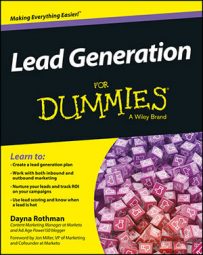Focus your lead-nurturing efforts on your existing database of sales leads. Just think about how much untapped revenue is in there right now! And consider how much money you have spent to get those leads to your database in the first place. Choose from one of these five basic lead-nurturing campaigns to turn those high-quality leads into customers.
Incoming lead-processing campaign
Think of lead nurturing as a way to build and cement a long-term relationship with your leads. An incoming lead-processing campaign is basically a welcome campaign that introduces your new leads to who your company is and what they can expect by opting-in to your communications. Understand where these leads are initially in your funnel, and create nurture tracks that address the buying process. Where they are in the buying journey can be determined by their initial lead score.
Your incoming processing campaign is probably a good place to ask leads to opt-in to your nurturing program. This means giving a lead the opportunity to decline communication with you. Communication compliance is a whole other topic, but know that all email marketers must comply with the CAN-SPAM Act. In other words, all email marketing communication must provide a way for a lead to opt out; you must give them the option to stop receiving email from you.
"Staying in touch" campaign
After your incoming lead-processing campaign, most marketers will add their leads to a stay in touch campaign. These campaigns are exactly what they sound like — staying in touch — and are the bread and butter to most nurture programs. Basically, over time, you can send the lead relevant educational material that helps lead her down the funnel.
A simple example of a stay in touch campaign might look like the following:
Email 1: Welcome email
Email 2: TOFU (top-of-funnel) asset 1
Email 3: TOFU asset 2
Email 4: TOFU blog post or infographic
Email 5: MOFU (middle-of-funnel) asset 1
Email 6: MOFU asset 2
Email 7: MOFU blog post or infographic
Email 8: Datasheet
Email 9: Customer testimonials
Email 10: Pricing sheet and demo request
Notice how each email drives your lead farther down your sales funnel — from early-stage assets, to mid-stage, and then finally, late-stage assets.
Accelerator campaign
Consider creating accelerator campaigns to move leads down the funnel at a faster rate. These nurturing campaigns are often triggered by specific behaviors, such as a lead downloading a specific type of content or visiting your pricing page. Also consider accelerator campaigns implemented at the end of a month or at the end of the year, to drive sales.
Here are some elements to keep in mind when planning accelerator trigger campaigns:
Know what behavior indicates a high level of interest.
Develop multiple tracks that speak to different levels of interest — for example, someone downloading a mid-funnel asset versus downloading a pricing sheet.
Use offers that spark immediate engagement — a $50 Visa card for a demo or sales meeting, a chance to win an iPad, and so on.
Interest-based campaign
Another type of nurturing track is the interest-based nurture track. Send the lead what you know he's interested in. If a lead comes to your site and downloads two e-books on personal finance, continue sending him content on personal finance versus sending him content on small business finance. Through interest-based campaigns, you can move your leads down the funnel, but also make sure that he stays engaged with your content at the same time.
Recycling-leads campaign
Make sure you have nurture tracks created for recycled leads. A recycled lead is a lead that sales determines is not sales-accepted — that is, someone who doesn't fit the ideal lead profile or who isn't ready to talk to sales. Therefore, sales sends that lead back to nurturing. But just because a lead isn't ready to buy at the time she is contacted doesn't mean she will never be ready to buy. Create lead recycle tracks based on the data that a sales rep collected during the call, such as decision timeframe and interests. That way, you can make sure you communicate with your leads in an appropriate fashion post-sales.

